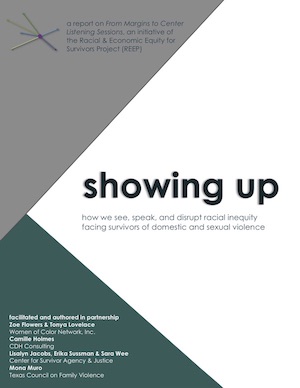
 Fear must not keep us from having bold conversations
Fear must not keep us from having bold conversations
Fear limits our ability as sexual and domestic violence prevention advocates to address the roots of violence. It’s the fear of talking about racial inequity – saying the wrong thing or being called racist – and also fear of retaliation for wanting to talk about it. In turn, we can recreate these same inequities within organizations. This conversation is for everyone – we all need to work from the places we have privilege.
Helping us along the way is a new report from The Center for Survivor Agency & Justice’s (CSAJ). Showing Up: How We See, Speak, and Disrupt Racial Inequity Facing Survivors discusses how this fear shows up for individuals, in organizations and in the movement. Luckily, the opposite of fear is courage, curiosity, trust, and even acceptance.
See it and speak it
I’m struggling. I admit it. This blog started as a book report – a safe, academic summary – not how this conversation has personally impacted me. Colleagues of color encouraged me to see the opportunity to dig deeper. Wanting action and dialogue is noble; acknowledging ways I cause or have caused my colleagues of color harm and been part of the problem creates stress and discomfort.
The more I learn about sexual violence and how we can prevent it, the more firmly I believe that to create a culture of respect and equity we must talk about accountability and self-reflection. And importantly, we need help having these conversations. I’ve been thinking about all the times I’ve been silent when I should have spoken, as well as when I didn’t see how much space I was taking up in a conversation. I’ve been thinking about how this movement tried to erase Tarana Burke from her own campaign and legacy. And I’ve been thinking of the ways mainstream organizations tokenize advocates of color. We all have to do the work to make any kind of change.
Doing the work
“Showing up” means we must more authentically engage in both inward and outward work for racial equity, and do so at the same time. The Showing Up report speaks eloquently about the inaccessibility of mainstream services to many survivors. Survivors at the intersections — whether they identify as LBGT, people of color, immigrants, indigenous, and/or having a disability — frequently are forced to either navigate systems that are biased, or opt out of receiving services from mainstream service providers. Biases go beyond behaviors of individual staff members and are woven into the structure of mainstream organizations. These biases impact access to safety systems and much-needed services.
The report also offers reflection questions to help open dialogue about this, and asks us to think about how racial bias shows up for survivors in many ways within programs, in outside services and institutions, in communities, and in policies. We must also acknowledge how this shows up internally, with survivors, in the work, with advocates of color, and in the movement. The report prompts, “As a person of color, what do you need to continue in the work? As a White person, what are some ways you can “be present, real, and see” colleagues of color?”
Stories and data illuminate racial inequity
The report outlines a few concrete scenarios offering readers quotes and lived experiences from listening sessions. Readers are asked to reflect on where they would place themselves and their organizations on a spectrum called the “Stages of Engagement.” These four categories include “discomfort and pushback,” “just the norm,” “awkward place,” and “mindful and working at it.”
Each affinity group agreed upon the recommendations and strategies in the report and connected individual and organizational needs to engage in racial equity as well as to heal from harm, share wisdom, and exchange a range of inspiring and innovative practices. Advocacy and DV program strategies, as well as coalition and legal services strategies, are listed. The report is quick to point out that the path towards equity is not a straight line. In each stage, though, there are strategies for change.
For me, this resonated because we are having this conversation internally at NSVRC in various workgroups that are focused on racial equity, and sometimes the meetings can be awkward, like when I had an idea for a way we could reflect on white supremacy culture in our workplace was interpreted differently than how I had meant it. I really wanted to make sure my coworkers know that it wasn’t my intention. But I know that intentions don’t always match impact, so I did not try to explain away the impact. And going forward, I’m going to use these reflection questions thoughtfully and consider how I hold myself accountable – like writing this blog and being open and vulnerable – so I can show up.
Thank you, Center for Survivor Agency & Justice and the collaborative partners and participants in this project. Bringing forward these tools for mindful engagement and acknowledgement of racial inequity helps us change the conversation.
